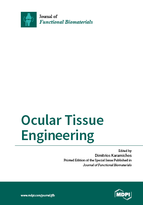Ocular Tissue Engineering
A special issue of Journal of Functional Biomaterials (ISSN 2079-4983).
Deadline for manuscript submissions: closed (30 November 2015) | Viewed by 121604
Special Issue Editor
Interests: corneal wound healing; cornea trauma; keratoconus; bioengineering; bioprinting; diabetic keratopathy
Special Issues, Collections and Topics in MDPI journals
Special Issue Information
Dear Colleagues,
Tissue engineering emerged back in the 1990s as a new concept to overcome the problem of tissue and organ failure. Over recent decades, there has been incredible progress towards the regeneration of tissues such as bone, heart valves, cartilage, cornea, and retina. In terms of ocular tissue engineering, despite the scientific and strategic incentive for reconstructing ocular tissues, there is also a tremendous need for novel therapeutic options in treating numerous eye diseases related to tissue failure. The aim of this Special Issue is to discuss tissue engineering applications of ocular tissues including but not limited to cornea, retina, and lenses. Both research and review articles focusing on ocular diseases and tissue engineering applications are welcome.
Dr. Dimitrios Karamichos
Guest Editor
Manuscript Submission Information
Manuscripts should be submitted online at www.mdpi.com by registering and logging in to this website. Once you are registered, click here to go to the submission form. Manuscripts can be submitted until the deadline. All submissions that pass pre-check are peer-reviewed. Accepted papers will be published continuously in the journal (as soon as accepted) and will be listed together on the special issue website. Research articles, review articles as well as short communications are invited. For planned papers, a title and short abstract (about 100 words) can be sent to the Editorial Office for announcement on this website.
Submitted manuscripts should not have been published previously, nor be under consideration for publication elsewhere (except conference proceedings papers). All manuscripts are thoroughly refereed through a single-blind peer-review process. A guide for authors and other relevant information for submission of manuscripts is available on the Instructions for Authors page. Journal of Functional Biomaterials is an international peer-reviewed open access monthly journal published by MDPI.
Please visit the Instructions for Authors page before submitting a manuscript. The Article Processing Charge (APC) for publication in this open access journal is 2700 CHF (Swiss Francs). Submitted papers should be well formatted and use good English. Authors may use MDPI's English editing service prior to publication or during author revisions.
Keywords
- tissue engineering
- cornea
- retina
- lens
- ocular diseases







